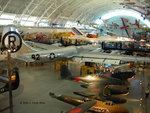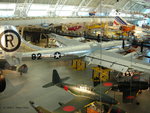M6A Seiran
| Country | Japan |
| Manufacturer | Aichi Kokuki KK |
| Primary Role | Torpedo Bomber |
| Maiden Flight | 1 November 1943 |
Contributor: C. Peter Chen
ww2dbaseThe M6A Seiran submarine-launched torpedo seaplanes were designed in response for a 1942 requirement for aircraft to be used in conjunction with the I-400-class submarine carriers of the Japanese Navy. They were of an all-metal construction, with control surfaces covered in fabric. The design was done so that two or three of them could be stowed aboard their submarine carriers, used to attack targets in surprise. Despite the complex folding system with their tails and wings, a seasoned crew could prepare all three aircraft for launch within 30 minutes. They made use of water-cooled engines, rather than air-cooled engines more prevalent in the Japanese Navy air service, so that they could be warmed up in their hangars while the submarine was still under water; this allowed their mother submarines to remain on the ocean surface for a smaller amount of time. Because the submarines would have no means to recover these seaplanes after a mission is carried out, the thought was that the submarine carriers would rescue the air crews and abandon the aircraft. The first prototype took flight over Ise Bay, Japan in 1943; although the test flight failed due to a non-responsive horizontal tail stabilizer, it nevertheless generated much interest with the Japanese naval leadership, who would soon issue an order for 42 combat aircraft and 2 trainer aircraft. It was around this time when the name Seiran was given, which was inspired by a 18th century woodblock print titled "Awazu no seiran". The Japanese Navy formed 631st Naval Air Group to operate these submarine-borne seaplanes. The group initially operated at Kure, Japan, but the presence of surrounding mountains which posed danger led to the relocation of the group by Yashiro Island further south in mid-Mar 1945. Shortly after, they joined their submarine carriers at Nanao on the coast of the Sea of Japan. Although the original vision for M6A Seiran attack aircraft involved dropping bombs on New York, New York, United States to demoralize the American people or destroying the top of the Gatun Locks thus using the power of water to seriously damage the Panama Canal, no such mission would ultimately be executed; planning for such strikes was canceled in early Jun 1945 in favor of targets closer to Japan. In Jul 1945, two I-400-class submarines each carrying three M6A1 Seiran aircraft and two modified AM-class submarines each carrying two M6A1 Seiran aircraft were sent on an attack on the American anchorage of Ulithi in the Caroline Islands, but the Japanese surrender was announced before the task force reached their target, and the mission was ultimately aborted. Thus, none of the M6A Seiran aircraft were ever used in combat.
ww2dbaseIn all, 29 aircraft of this design were built, including 8 M6A1 prototypes, 18 M6A1 production aircraft, 2 M6A1-K Nanzan land-based trainers, and 1 M6A2 prototype. Production ceased in Jul 1945.
ww2dbaseSources:
John Geoghegan, Operation Storm
Wikipedia
Last Major Revision: Aug 2008
M6A Seiran Timeline
| 15 May 1942 | Aichi received a request to design the world's first propose-built submarine-borne attack aircraft. |
| 8 Nov 1943 | Aichi held the first test flight of the submarine-borne attack aircraft M6A1 Seiran over Ise Bay. Lieutenant Commander Tadashi Funada was the chief test pilot. The test was a failure due to a non-responsive horizontal tail stabilizer, but it nevertheless generated much interest with the Japanese naval leadership. |
| 15 Nov 1944 | Japanese Navy pilot Ensign Katsuo Takahashi was dispatched to Aichi's factory to take delivery of a completed Seiran aircraft for flight testing. |
| 24 Nov 1944 | Japanese Navy officially accepted M6A Seiran seaplane for service. |
| 15 Dec 1944 | Japanese Navy 6th Fleet established Submarine Squadron 1 for the operation of long range carrier submarines. By this time, however, none of the Seiran attack aircraft were ready for operational service. |
| 13 Jan 1945 | Another M6A Seiran aircraft was completed by Aichi. |
| 10 Apr 1945 | Ten Seiran seaplanes performed a practice flight over Fukuyama, Japan to familiarize the crews with flights over densely populated areas in case they were to receive an order to attack US cities. After the exercise, Second Lieutenant Ichiyoshi's aircraft crashed on water landing; Ichiyoshi was killed, and the observer survived the crash. |
| 13 Jun 1945 | The Seiran aircraft flown by Lieutenant Masuo Egami and Warranty Officer Hisayoshi Kimoto crashed in a mountain on the coast of Nanao Bay, Japan. |
SPECIFICATIONS
M6A1
| Machinery | One Aichi Atsuta Type 32 inverted V-12 liquid-cooled engine rated at 1,400hp |
| Armament | 1x12.7mm Type 2 machine gun, 1x torpedo or 800kg of bombs |
| Crew | 2 |
| Span | 12.26 m |
| Length | 11.64 m |
| Height | 4.58 m |
| Wing Area | 27.00 m² |
| Weight, Empty | 3,362 kg |
| Weight, Loaded | 4,250 kg |
| Weight, Maximum | 4,445 kg |
| Speed, Maximum | 474 km/h |
| Speed, Cruising | 296 km/h |
| Service Ceiling | 9,900 m |
| Range, Normal | 1,190 km |
Photographs
 |  |  |  |
Did you enjoy this article or find this article helpful? If so, please consider supporting us on Patreon. Even $1 per month will go a long way! Thank you. Share this article with your friends: Stay updated with WW2DB: |
Visitor Submitted Comments
All visitor submitted comments are opinions of those making the submissions and do not reflect views of WW2DB.
- » Wreck of USS Edsall Found (14 Nov 2024)
- » Autumn 2024 Fundraiser (7 Nov 2024)
- » Nobel Peace Prize for the Atomic Bomb Survivors Organization (11 Oct 2024)
- » Wreck of USS Stewart/DD-224 Found (2 Oct 2024)
- » See all news
- » 1,150 biographies
- » 337 events
- » 43,917 timeline entries
- » 1,241 ships
- » 350 aircraft models
- » 207 vehicle models
- » 374 weapon models
- » 123 historical documents
- » 260 facilities
- » 470 book reviews
- » 28,541 photos
- » 432 maps
Thomas Dodd, late 1945
Please consider supporting us on Patreon. Even $1 a month will go a long way. Thank you!
Or, please support us by purchasing some WW2DB merchandise at TeeSpring, Thank you!
6 May 2010 12:34:30 PM
The I-400 series submarine had a small crane which it could use to lift the aircraft back onto the deck of the submarine. The folding and storage procedure was to be repeated as each aircraft returned and landed in the water.